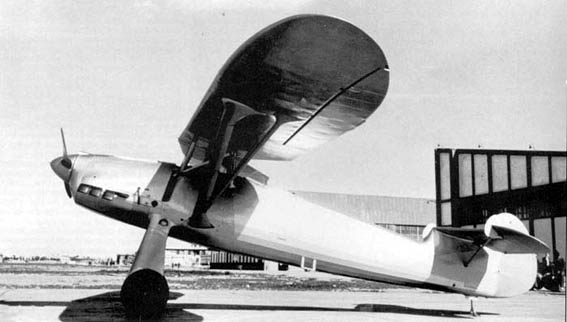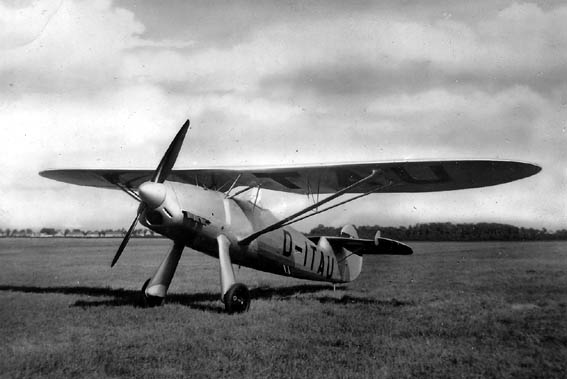 | ||
 |
 |
 |
 |
 |
 |
A Strange Affair Focke-Wulf Fw 56 Stösser aircraft to Haile Selassie, Yemen or Spain? © Lennart Andersson |
Just like history in general has its white spots, the history of aviation has its enigmas and mysteries. Sometimes information is found in the archives that cannot be immediately explained. There might be notes that perhaps seem to be some kind of error made by the clerk or officer who once typed the document, or data that do not agree at all with other previously known information.
In a file kept by the archive of the German Foreign Ministry (Auswärtiges Amt) there is a document titled "List of war material exports approved by the Ausfuhr-Gemeinschaft für Kriegsgerät (Society for Export of War Material), 1 November 1935 - 31 October 1936". In this list there is an entry under the heading Aircraft that reads "Yemen, RM 98,000". Having studied aviation in Yemen for several years down to the smallest detail I considered myself competent enough to discard this information as erroneous when I found it. The only explanation that I could think of was that perhaps engines or spare parts, and not complete aircraft were delivered, as not the smallest indication of any German aircraft exports to Yemen can be found in other sources. I knew for sure that no aircraft were active in Yemen in 1936 and certainly none that would need German spare parts worth 98,000 Reichsmark (RM). It is true that the Imam of Yemen had acquired three Junkers aircraft in 1927, but as far as known they were never flown after 1928. (See Wings Over the Desert. Aviation on the Arabian Peninsula, on this site) A list of all aircraft exported in 1936 that I found in the German Militärarchiv at Freiburg supported my conclusions, as there is no mentioning of Yemen whatsoever. Then a new document turned up, which made these recalcitrant ill-fitting pieces fall into place! In 1945 forty-one index cards were captured by the United States Strategic Air Forces in Europe (USSTAF) at the Focke-Wulf factory in Germany. As the Americans were interested to see what foreign connections the German war material industries had maintained before and during the war, they were sent to Headquarters, Allied Expeditionary Air Force in June 1945 for post-hostilities intelligence purposes. A compilation was made from the index cards and one of the entries in this document shows that three Focke-Wulf Fw 56 Stösser single-seat light fighter-trainers, c/ns 901, 902 and 1366, were ordered for Yemen and were ready for delivery in April 1936! So what actually happened? Why were these aircraft not included in the official export listing and why is nothing known about them in Yemeni service? In fact I remembered having read about a strange operation with exactly three Fw 56 Stösser aircraft, but that transaction involved Ethiopia and Republican Spain, and not Yemen. However, a check of these facts all over again finally made it possible to now establish a fairly certain assertion about what actually happened back in those days about 70 years ago and it is a quite interesting and unusual story! 
In October 1935 Italy attacked Ethiopia (then known as Abyssinia). The Ethiopian Army had a very small air force consisting of a few Potez 25 two-seaters and a small number of light aircraft and transports. British arms dealer Captain John Ball of the Soley Armament Company provided several consignments of arms to the Ethiopian emperor, Haile Selassie, who otherwise had to struggle hard to find ways to get arms for the defence of his country. As we know his efforts to obtain international support through the League of Nations were deplorably fruitless. In what must be one of the most unlikely arms deals in history, John Ball was apparently able to buy three Fw 56A Stössers from Focke-Wulf. In the first place these advanced single-seat aircraft can hardly be considered in any way suitable for use by inexperienced pilots in Africa. What purpose would they have served? Secondly, how could Focke-Wulf be persuaded to pick three aircraft out of production batches that were already ordered by and earmarked for the Reichsluftfahrtministerium (RLM) and the Luftwaffe? German aircraft exports were normally strictly monitored and controlled by government agencies and all export deals had to be approved. Production for export was often separate from the RLM-batches ordered for the Luftwaffe and for State-controlled organisations. One can only speculate on how these aircraft were released for export, if they ever were formally released. In any case they were loaded on board the 'Santa Maria' at Antwerp on 4 April 1936, complete with machine guns, ammunition and bombs, and three Germans had apparently been hired to assemble, and possibly test fly them. Ball alleged that he had acquired the aircraft with the aid of a Swiss intermediary, and it is now apparent that the final destination had been given as 'Yemen'. Swiss agencies normally paid in hard currency, which might have 'greased' the deal through the German Government bureaucracy. The war in Ethiopia ended early in May 1936, which caught the aircraft still on their way out, as the ship had just reached Gibraltar. Delivery to Ethiopia was now out of the question. For three months Ball's agent tried to find a new buyer for the aircraft and in the meanwhile the ship was refused to dock and sailed from port to port. He finally tried to disembark them in Great Britain on Lundy Island, which Martin Coles Harmon and Serge Rubinstein had bought and declared to be an independent kingdom with Harmon as king (!), but the British Board of Trade and Home Office intervened and prohibited unloading of the aircraft. The ship finally returned to Antwerp and the crated aircraft were transferred to another ship, the 'Stanmore', in June 1936. This ship was owned by an acquaintance of Ball's, Jack Billmeir, who had been trading with Spain for many years, and who owned the Stanhope Steamship Company. By 1938 he had in fact become the largest single shipper of supplies to the Republican Government. When the Spanish Civil War erupted in July 1936 Ball had apparently already sold the Stössers to a London representative of the Nationalist rebels. The Belgian authorities had impounded the machine guns, ammunition and bombs, but all this material 'disappeared' in August and when the aircraft could no longer be delivered complete with armament the Nationalists cancelled the deal. By then the 'Stanmore' had sailed to Rotterdam in Holland to evade an anticipated Belgian embargo on all aviation equipment destined to Spain. Ball then contacted the other side, the Republican Government, and managed to sell the aircraft to one of their agents in Holland. The 'Stanmore' left Antwerp on 1 October and arrived in Alicante ten days later. The Fw 56s were assembled there and were then used for flying training at La Ribera, near San Javier, and at Archena. The first Fw 56 had taken to the skies late in 1933 and had been followed by four more prototypes and seven pre-series (Null-Serie) aircraft. The Luftwaffe received the first production Fw 56As in July 1935 and by the time production ended late 1937 a total of 445 had been built for them. Six examples were exported to Bulgaria in December 1936 and in the following year 17 went to Hungary and nine to Austria, but these were built specially against foreign orders and not taken from RLM production batches like the 'Yemenite' Stössers. Acknowledgements I would like to thank Tony Jones and Jim Kitchens for providing valuable background information. Much of the 'Spanish connection' comes from Gerald Howson's eminent book on clandestine aircraft deliveries to Spain during the Civil War. |